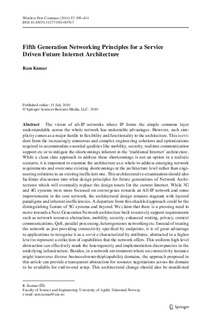| dc.contributor.author | Kumar, Ram | |
| dc.date.accessioned | 2011-10-13T11:21:42Z | |
| dc.date.available | 2011-10-13T11:21:42Z | |
| dc.date.issued | 2011 | |
| dc.identifier.citation | Kumar, R. (2011). Fifth Generation Networking Principles for a Service Driven Future Internet Architecture. Wireless Personal Communications, 57(3), 393-411. doi: 10.1007/s11277-010-0076-7 | en_US |
| dc.identifier.issn | 0929-6212 | |
| dc.identifier.uri | http://hdl.handle.net/11250/137928 | |
| dc.description | Published version of an article published in Wireless Personal Communications, vol. 57:393-411. Also available from the publisher at: http://dx.doi.org/10.1007/s11277-010-0076-7 | en_US |
| dc.description.abstract | The vision of all-IP networks where IP forms the simple common layer understandable across the whole network has undeniable advantages. However, such simplicity comes as a major hurdle to flexibility and functionality to the architecture. This is evident from the increasingly numerous and complex engineering solutions and optimizations required to accommodate essential qualities like mobility, security, realtime communication support etc or to mitigate the shortcomings inherent in the 'traditional Internet' architecture. While a clean slate approach to address these shortcomings is not an option in a realistic scenario, it is important to examine the architecture as a whole to address emerging network requirements and overcome existing shortcomings at the architecture level rather than engineering solutions to an existing inefficient one. This architectural re-examination should also facilitate discussion into what design principles for future generations of Network Architectures which will eventually replace the design tenets for the current Internet. While 3G and 4G systems were more focussed on convergence towards an All-IP network and some improvements in the core network, the architectural design remains stagnant with layered paradigms and inherent inefficiencies. A departure from this shackled approach could be the distinguishing feature of 5G systems and beyond. We claim that there is a pressing need to move towards a Next Generation Network architecture built to natively support requirements such as network resource abstraction, mobility, security, enhanced routing, privacy, context communications, QoS, parallel processing, heterogeneous networking etc. Instead of treating the network as just providing connectivity specified by endpoints, it is of great advantage to applications to recognise it as a service characterized by attributes, abstracted to a higher level to represent a collection of capabilities that the network offers. This uniform high level abstraction can effectively mask the heterogeneity and implementation discrepancies in the underlying infrastructure. Besides, in a network environment where an connectivity instance might transverse diverse business/ownership/capability domains, the approach proposed in this article can provide a transparent abstraction for resource negotiations across the domain to be available for end-to-end setup. This architectural change should also be manifested according to the principles of SOA to ensure interoperability, backwards compatibility and migration. In this article, we introduce a Service Oriented framework and network architecture aimed at tackling the heterogeneity of emerging requirements and proposed solutions into a coherent interoperable architecture using Web Services specifications as the basic standards. We propose to model the new architecture on relationships between entities and discuss the motivation this new architecture in the form of a new framework called ROSA. | en_US |
| dc.language.iso | eng | en_US |
| dc.publisher | Springer | en_US |
| dc.subject | Future Internet, network architecture, service oriented architecture, ROSA | en_US |
| dc.title | Fifth generation networking principles for a service driven future Internet architecture | en_US |
| dc.type | Journal article | en_US |
| dc.type | Peer reviewed | en_US |
| dc.subject.nsi | VDP::Mathematics and natural science: 400::Information and communication science: 420::Theoretical computer science, programming languages and programming theory: 421 | en_US |
| dc.source.pagenumber | 393-411 | en_US |
| dc.source.volume | 57 | en_US |
| dc.source.journal | Wireless Personal Communications | en_US |
